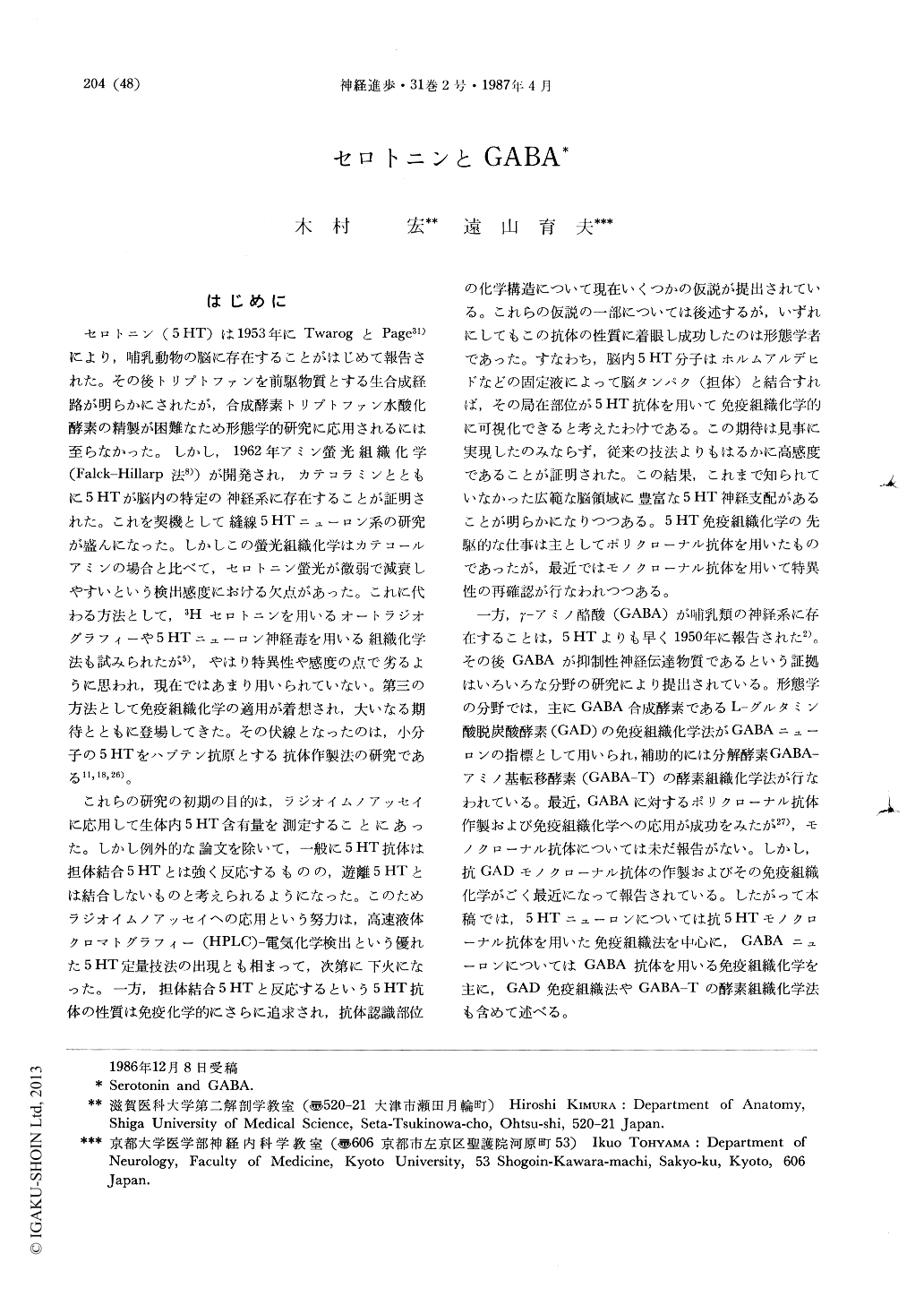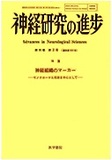Japanese
English
- 有料閲覧
- Abstract 文献概要
- 1ページ目 Look Inside
はじめに
セロトニン(5HT)は1953年にTwarogとPage31)により,哺乳動物の脳に存在することがはじめて報告された。その後トリプトファンを前駆物質とする生合成経路が明らかにされたが,合成酵素トリプトファン水酸化酵素の精製が困難なため形態学的研究に応用されるには至らなかった。しかし,1962年アミン螢光組織化学(Falck-Hillarp法8))が開発され,カテコラミンとともに5HTが脳内の特定の神経系に存在することが証明された。これを契機として縫線5HTニューロン系の研究が盛んになった。しかしこの螢光組織化学はカテコールアミンの場合と比べて,セロトニン螢光が微弱で減衰しやすいという検出感度における欠点があった。これに代わる方法として,3Hセロトニンを用いるオートラジオグラフィーや5HTニューロン神経毒を用いる組織化学法も試みられたが5),やはり特異性や感度の点で劣るように思われ,現在ではあまり用いられていない。第三の方法として免疫組織化学の適用が着想され,大いなる期待とともに登場してきた。その伏線となったのは,小分子の5HTをハプテン抗原とする抗体作製法の研究である11,18,26)。
これらの研究の初期の目的は,ラジオイムノアッセィに応用して生体内5HT含有量を測定することにあった。しかし例外的な論文を除いて,一般に5HT抗体は担体結台5HTとは強く反応するものの,遊離5HTとは結合しないものと考えられるようになった。このためラジオイムノアッセイへの応用という努力は,高速液体クロマトグラフィー(HPLC)−電気化学検出という優れた5HT定量技法の出現とも相まって,次第に.下火になった。一方,担体結合5HTと反応するという5HT抗体の性質は免疫化学的にさらに追求され,抗体認識部位の化学構造について現在いくつかの仮説が提出されている。これらの仮説の一部については後述するが,いずれにしてもこの抗体の性質に着眼し成功したのは形態学者であった。すなわち,脳内5HT分子はホルムアルデヒドなどの固定液によって脳タンパク(担体)と結合すれば,その局在部位が5HT抗体を用いて免疫組織化学的に可視化できると考えたわけである。この期待は見事に実現したのみならず,従来の技法よりもはるかに高感度であることが証明された。この結果,これまで知られていなかった広範な脳領域に豊富な5HT神経支配があることが明らかになりつつある。5HT免疫組織化学の先駆的な仕事は主としてポリクローナル抗体を用いたものであったが,最近ではモノタローナル抗体を用いで特異性の再確認が行なわれつつある。
Visualization of serotonin (5 HT) neuronal structure was first achieved by fluorescent histo-chemistry, so-called Falck-Hillarp's method, in 1962. The technique opened a wide field for studying serotoninergic raphe systems in relation to various brain function. However, informations obtained by this method were considerably limited as compared with those obtained by bio-chemical and physiological approaches. This is mainly because the low sensitivity of the method for detecting yellow 5 HT fluorescence which was rapidly fading out by ultraviolet irradiation.Alternative methods, such as 〔3H〕-5 HT auto-radiography and false transmitter histochemistry, has been developed, but they also have difficulties in specificity or sensitivity.
The third and latest methods depend upon the immunohistochemical principle, and the most successful results have been obtained by using antibodies against haptenic 5 HT. Initially, such antibodies had been developed for radioimmuno-assay for measuring tissue 5 HT contents. However, immunochemical studies suggested that the 5 HT antibodies did not recognize free molecule of 5 HT but recognize 5 HT which was bound to large molecules. This somewhat unique property in antibody recognition can smartly be employed in morphological study, since recent immuno-histochemical methods always include tissue fixa-tion whereby endogenous 5 HT molecules are bound to tissue proteins. As the situation is such that, the specificity of 5 HT antibodies has a key for the conclusion of the immunohistochemical results. The use of monoclonal antibody, therefore, is particularly important for the identification of 5 HT. Here reviews a recent advance in such methodology using 5 HT monoclonal antibody, and an example of the application to quantitative neurotransmitter histochemistry is given.

Copyright © 1987, Igaku-Shoin Ltd. All rights reserved.


